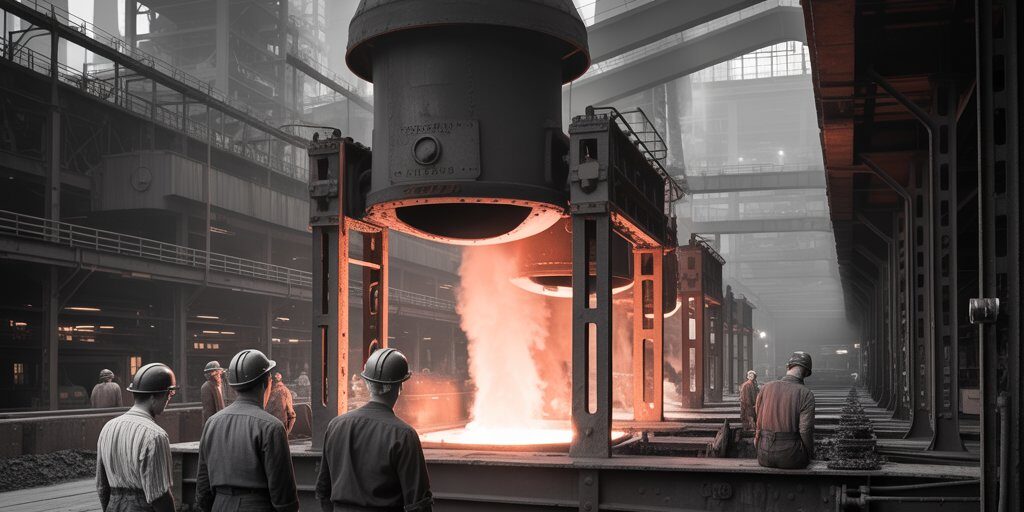Introduction: The Steel City Goes to War
In the early 1940s, as World War II engulfed the globe, Pittsburgh, Pennsylvania, stood as a beacon of industrial strength. Known as the “Steel City,” Pittsburgh was already a manufacturing giant, but the war elevated its role to new heights. The city became the “Arsenal of the Allegheny,” a critical hub in the Allied war machine, producing the steel, aluminum, and other materials that fueled victory. Located at the confluence of the Allegheny, Monongahela, and Ohio rivers, Pittsburgh’s strategic geography, abundant natural resources, and skilled workforce made it an ideal center for wartime production. When the United States entered the war after the Japanese attack on Pearl Harbor on December 7, 1941, Pittsburgh’s industries shifted into high gear, transforming the city into a powerhouse of the “Arsenal of Democracy.” This article explores Pittsburgh’s multifaceted contributions to World War II, from its industrial might to the social changes on the homefront, highlighting how the city not only supported the Allied victory but also reshaped its own future.
Steel Production: The Backbone of Victory
Pittsburgh’s steel industry was the cornerstone of its wartime contributions. U.S. Steel, the world’s largest steel producer at the time, played a pivotal role. During WWII, U.S. Steel ranked 16th among U.S. corporations in the value of its war production contracts, supplying hundreds of millions of tons of steel for planes, ships, tanks, and other military equipment (U.S. Steel History). The company built 119 Landing Ships/Tanks (LSTs), reducing construction time from 260 days to just 30 days through innovative production methods. By 1942, Pittsburgh’s steel production had increased by more than 200%, making it the world’s leading steel producer (National Park Service).
Other steel companies, such as Jones & Laughlin Steel Company and Allegheny Ludlum Steel Corporation, also made significant contributions. Jones & Laughlin, the fourth-largest steel producer globally by 1940, produced over 4.8 million tons of steel annually, supporting the war effort with armor, railway components, and specialized turbine equipment (Google Arts & Culture). Allegheny Ludlum developed alloys for aircraft and tanks, enhancing their durability and performance. The Mesta Machine Company produced over half of the 155mm gun tubes used in the war, while Pittsburgh’s shipyards built 20% of the LSTs, along with sub chasers and other transport craft.
The war effort led to massive factory expansions. The Homestead Works of U.S. Steel, for example, expanded significantly, displacing 8,000 residents to increase production capacity. Pittsburgh’s steel mills produced a staggering 95 million tons of steel for the war effort—more than all the Axis powers combined (Pittsburgh Beautiful). This industrial output was crucial for the Allied victory, earning Pittsburgh a place in history as a key component of the war effort. For more on U.S. Steel’s history, see U.S. Steel in Pittsburgh.
| Steel Company | Key Contributions | Production Impact |
|---|---|---|
| U.S. Steel | Built 119 LSTs, supplied steel for planes, ships, tanks | Ranked 16th in war contracts, peak employment 340,000 in 1943 |
| Jones & Laughlin | Produced 4.8 million tons annually, armor and railway components | Fourth-largest steel producer globally |
| Allegheny Ludlum | Developed alloys for aircraft and tanks | Enhanced military equipment durability |
| Mesta Machine | Produced over 50% of 155mm gun tubes | Critical for artillery production |
Aluminum Production: Powering the Air War
While steel was vital, aluminum became equally important for the war effort, particularly for aircraft production. Alcoa, founded in Pittsburgh as the Pittsburgh Reduction Company in 1888, was the leading producer of aluminum in the United States. During WWII, Alcoa significantly increased its production, supplying aluminum for military aircraft, ships, and other equipment (Alcoa Wikipedia). Aluminum’s lightweight and durable properties made it ideal for fighter planes, bombers, and even mess kits, supporting the Allies’ air superiority, a key factor in their victory.
Alcoa’s contributions included operating the Hurricane Creek Alumina Plant in Arkansas, the largest alumina facility ever built at the time, which processed bauxite into alumina for aluminum production (Hot Springs Sentinel Record). The company’s Pittsburgh roots and its expansion during the war underscored the city’s importance in supplying critical materials. Alcoa’s aluminum was used in iconic aircraft like the B-17 Flying Fortress and P-51 Mustang, which played pivotal roles in the war. For more on Alcoa’s history, see Alcoa’s Legacy in Pittsburgh.
Other Industries: Innovation Beyond Steel and Aluminum
Pittsburgh’s industrial contributions extended beyond steel and aluminum. Westinghouse Electric Corporation, headquartered in Pittsburgh, played a significant role in the war effort. Westinghouse produced the first operational American turbojet for the US Navy in 1943 and developed jet engines like the J30 and J34, which powered early jet fighters such as the McDonnell Douglas FH-1 Phantom (Westinghouse Wikipedia). The company’s Mansfield plant in Ohio manufactured bomb band adapters to allow American bombs to be used on British planes, showcasing its versatility (Mansfield News Journal).
The glass industry also contributed, with Pittsburgh companies like Libbey-Owens-Ford Glass Company producing specialized glass for airplane cockpits and optical equipment. The Bantam Car Company in Butler County produced the first Jeeps, which became iconic military vehicles, while the Heinz factory manufactured gliders, and Beaver County produced propellers for aircraft (TribLIVE). These diverse contributions highlight Pittsburgh’s role as a multifaceted industrial hub. For more on Westinghouse’s contributions, see Westinghouse During WWII.
Workforce Changes: Rosie the Riveter and the Double V Campaign
The war brought profound changes to Pittsburgh’s workforce. With over 113,000 U.S. Steel employees alone enlisting or being drafted, women and minorities stepped into roles traditionally held by men (U.S. Steel History). Women became “Rosie the Riveters,” working in factories, shipyards, and offices. In Pittsburgh, women held one in every eight jobs at U.S. Steel, taking on roles across operating facilities. The iconic “We Can Do It!” poster, symbolizing women’s contributions, was created for Westinghouse’s campaign to boost morale among its female workers (TribLIVE).
African Americans also found new opportunities, migrating to Pittsburgh from the South during the Second Great Migration. The “Double V” campaign—victory over fascism abroad and victory over racism at home—was popularized by the Pittsburgh Courier, a local African American newspaper, following a letter by James G. Thompson in 1942 (National Park Service). This campaign highlighted the dual struggle for freedom and equality, influencing the civil rights movement. For more on the workforce, see Women in WWII Pittsburgh.
| Workforce Group | Role in War Effort | Social Impact |
|---|---|---|
| Women | Filled factory and office roles, “Rosie the Riveter” | Challenged gender norms, influenced post-war workforce |
| African Americans | Migrated for industrial jobs, launched Double V campaign | Advanced civil rights, highlighted racial inequalities |
Military Contributions: Heroes from the Steel City
Pittsburgh and its surrounding areas made significant military contributions. Allegheny County suffered 3,982 casualties during the war, and eight soldiers from the region received the Medal of Honor for their bravery (National Park Service). Local heroes included Michael Strank from Johnstown, who was part of the famous Iwo Jima flag-raising on February 23, 1945, and Ronald Bagley from Indiana County, who co-invented an airborne truck system used in the war (TribLIVE).
The city’s industries supported the military by producing essential equipment. The USS Pittsburgh, a heavy cruiser, served in the Pacific fleet, earning two battle stars for its actions at Iwo Jima and Okinawa (Popular Pittsburgh). Pittsburgh also produced the Norden bombsight, a critical technology for accurate bombing, used in strategic campaigns (TribLIVE).
Homefront: Unity and Sacrifice
On the homefront, Pittsburghers supported the war effort through rationing, victory gardens, and scrap drives. Rationing began in 1942, with families conserving resources like sugar, gasoline, and meat. Victory gardens were planted in backyards and public spaces, such as Schenley Park, to supplement food supplies. Scrap drives collected metal, rubber, and other materials for recycling into war goods, with children gathering tin cans and communities organizing events (TribLIVE).
Bond drives and fundraising events were common, with citizens purchasing war bonds to finance the war effort. The Pittsburgh Courier’s “Double V” campaign galvanized the community, fostering a sense of unity and purpose. Walter Patton, a Glassport resident drafted in 1943, recalled the homefront’s dedication: “Everything was rationed because everything we had was being used in the war with Germany and Japan” (TribLIVE). For more on the homefront, see Pittsburgh’s Homefront During WWII.
Aftermath: A City Transformed
The war had a profound impact on Pittsburgh. The industrial boom provided a temporary reprieve from the Great Depression, with $511 million spent on factory expansion, the sixth largest among U.S. industrial centers (National Park Service). However, the city’s reliance on steel made it vulnerable when the industry declined in the 1970s due to foreign competition and technological changes (Wikipedia).
The war also left a legacy of innovation and resilience. Technologies developed during WWII, such as jet engines and advanced alloys, laid the foundation for new industries like electronics and aerospace. Socially, the increased participation of women and minorities in the workforce influenced civil rights movements, with the “Double V” campaign serving as a precursor to the 1960s activism. Pittsburgh’s designation as a WWII Heritage City by the National Parks Service in 2022 underscores its lasting impact (The Center Square).
Lesser-Known Stories: Hidden Gems of Pittsburgh’s War Effort
Pittsburgh’s WWII contributions include several lesser-known stories. The USS Pittsburgh, commissioned in 1944, played a crucial role in the Pacific, surviving a typhoon in 1945 that damaged its bow but continuing to serve (Popular Pittsburgh). The city’s production of the Norden bombsight, manufactured by local firms, was a closely guarded secret that enhanced the precision of Allied bombing campaigns.
Another unique contribution was the Bantam Car Company’s development of the Jeep in 1940, with prototypes tested in Butler County. The Jeep became a symbol of American ingenuity, used extensively in every theater of the war (TribLIVE). Additionally, Pittsburgh’s glass industry produced specialized lenses for the military, including those used in the Norden bombsight, showcasing the city’s diverse industrial capabilities.
Conclusion: The Arsenal’s Lasting Legacy
Pittsburgh’s role in World War II was pivotal, earning it the title “Arsenal of the Allegheny.” The city’s industries produced the steel, aluminum, and other materials that fueled the Allied victory, while its workforce, including women and minorities, transformed societal norms. The homefront efforts, from rationing to scrap drives, demonstrated the community’s unwavering commitment. While the war brought economic prosperity, it also highlighted Pittsburgh’s vulnerabilities, setting the stage for future challenges. Nevertheless, the city’s contributions to the war effort and its legacy of innovation and resilience continue to shape its identity, as recognized by its WWII Heritage City designation. Pittsburgh’s story is one of sacrifice, ingenuity, and unity—a testament to the Steel City’s enduring spirit.









